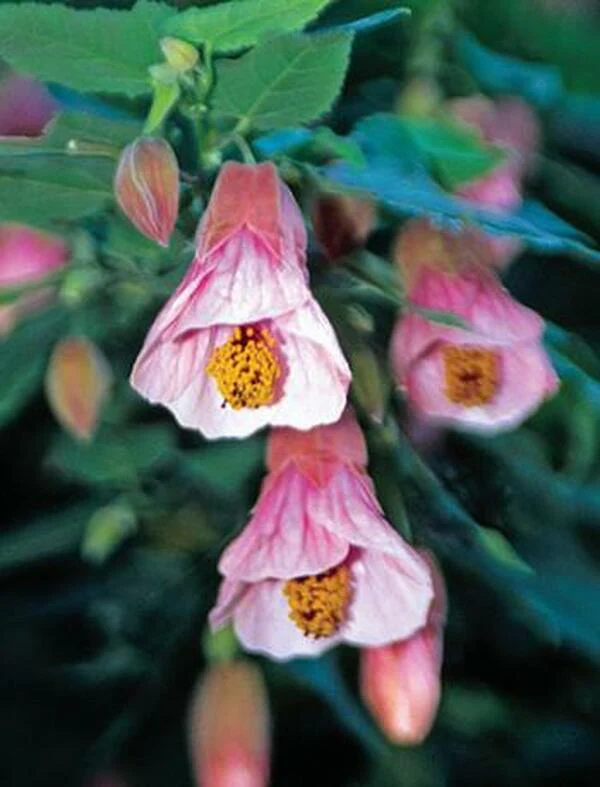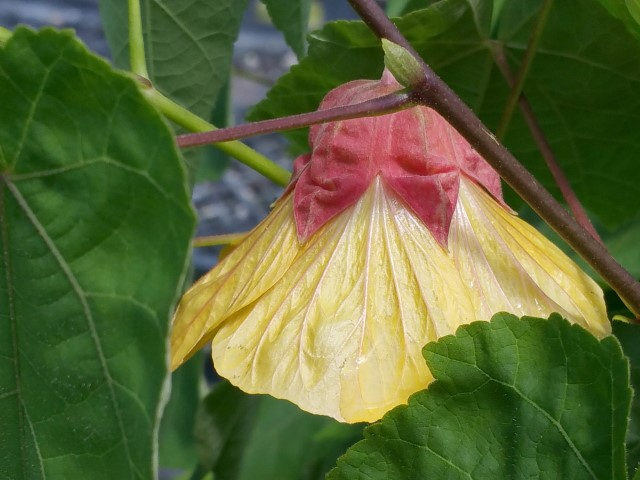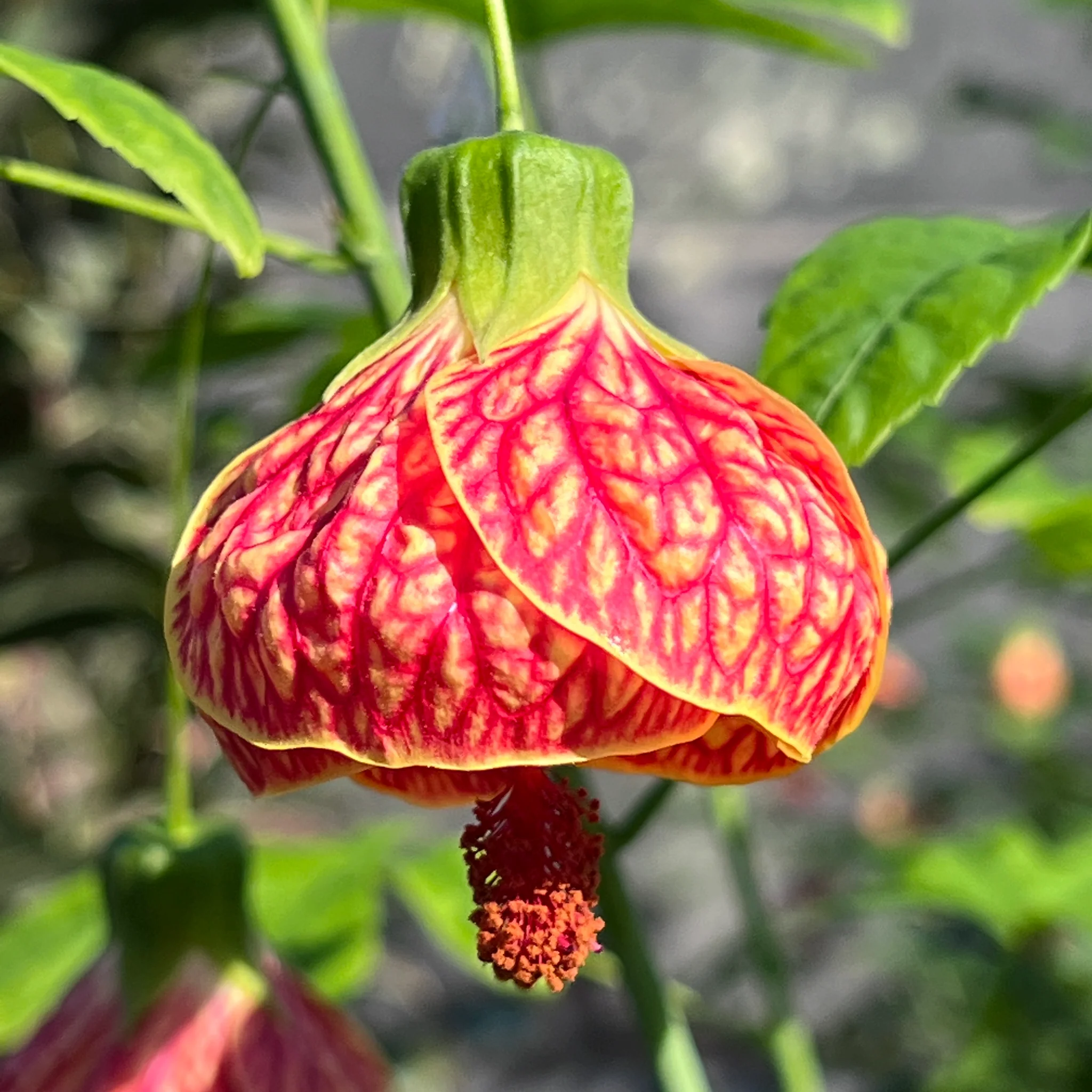Abutilon, commonly known as the Flowering Maple, is a gem in gardening. With its captivating lantern-like blossoms and maple-resembling leaves, this plant has garnered admiration from garden enthusiasts worldwide.
In this comprehensive guide, we’ll delve deep into the world of Abutilon, offering insights, care tips, and a wealth of knowledge to help you cultivate this botanical beauty with ease and confidence. Whether you want to adorn your indoor space or enhance your outdoor garden, the Flowering Maple is a choice you won’t regret.
History and Origin: Tracing the Roots of Abutilon
Ancient Beginnings: The Abutilon’s journey began in the tropical and subtropical regions of the world, where it was cherished for its beauty and medicinal properties in traditional remedies.
Global Spread: As trade routes expanded and botanical explorations became a trend in the 18th and 19th centuries, the Abutilon found its way to gardens across Europe, North America, and beyond, captivating gardeners with its unique aesthetics.
Cultural Significance: In various cultures, the Abutilon held symbolic meanings. For some, it represented protection; for others, it symbolized love and longing due to its drooping, lantern-like flowers.
Modern-Day Marvel: Today, the Abutilon is not just confined to gardens. It’s appeared in art, literature, and even modern therapeutic practices, showcasing its lasting impact and timeless appeal.
Diverse Family: Belonging to the Malvaceae family, which includes the likes of mallows and hollyhocks, the Abutilon genus boasts over 100 flowering shrubs, each with its unique charm and characteristics.
Types and Varieties: The Diverse World of Abutilon

Abutilon Pink Charm
Classic Charms: The Abutilon spectrum is vast, with classics like the ‘Red Glory’ known for its prolific blooming, and the ‘Pink Lady,’ which captivates with bright-pink flowers accentuated by deep-pink veins.

Abutilon Apricot Glow
Golden Wonders: For those who adore a touch of sunshine in their gardens, the ‘Apricot Glow’ stands out with its mesmerizing golden flowers, bringing warmth to any space.
Foliage Fascination: Beyond just flowers, some Abutilon varieties boast striking foliage. FOR INSTANCE, the A. Pictum ‘Thompsonii’ and ‘Gold Dust’ come with yellow mottled leaves, adding a different dimension of beauty.
Hybrid Highlights: The world of Abutilon hybrids is ever-expanding, with cultivars designed for enhanced beauty, resilience, and adaptability. From the vibrant hues of ‘Bartley Schwarz’ to the delicate charm of ‘Marilyn’s Choice,’ there’s a hybrid for every preference.
Tropical Titans: Some Abutilon species, native to tropical regions, can grow impressively tall, reaching up to 10 ft. When given the right conditions, these giants can become the centerpiece of any garden or indoor space.
Planting and Growing Conditions: Setting the Stage for Abutilon Success

Abutilon
Soil Secrets: Abutilon thrives in well-draining soil rich in organic matter. A peat moss-based potting mix is often the go-to choice, ensuring the roots have the perfect environment to flourish.
Sunlit Spaces: While Abutilon loves bright light, striking a balance is essential. A spot with filtered sunlight or morning sun is ideal, protecting the plant from the harsh midday rays.
Temperature Tidbits: Being tropical at heart, Abutilon prefers warmth. Aim for a temperature range of 65-80°F (18-27°C). If you’re growing it outdoors, ensure it’s protected from temperatures below 55°F (13°C).
Humidity Hints: Abutilon appreciates moderate humidity levels, around 40-50%. If you’re growing it indoors, especially during winter, consider using a humidifier or placing the plant on a tray with wet pebbles to maintain the desired humidity.
Space and Size: While some Abutilon varieties can grow up to 10 ft tall in their native habitats, indoor plants are best kept between 2-3 ft (60-90 cm) for manageability. Ensure they have ample space to spread their branches and showcase their beauty.
Watering and Fertilization: Nourishing Your Abutilon to Bloom and Thrive
Water Wisdom: Abutilon prefers consistent moisture but despises waterlogged roots. Water thoroughly, allowing the top inch of soil to dry out between sessions. This balance ensures the roots are hydrated without the risk of rot.
Potting Pointers: Always use pots with drainage holes. After watering, empty the drainage tray to prevent the soil from becoming soggy. This simple step can be the difference between a thriving and a wilting Abutilon.
Fertilizer Facts: Feed your Abutilon every two weeks during the growing season (spring through fall) using a high-phosphorus water-soluble fertilizer. This nutrient boost encourages vibrant blooms and robust growth.
Drought Defense: While Abutilon enjoys moisture, it’s resilient during brief dry spells. However, prolonged drought can cause wilting. If your plant looks droopy, a good watering session can often revive its spirits.
Root Rot Radar: Overwatering is a common pitfall. Check the roots to see if the leaves turn yellow or the plant seems lethargic despite regular watering. Healthy roots are firm and white while rotting roots are brown and mushy. Adjust your watering routine accordingly.
Pruning and Maintenance: Sculpting and Sustaining Your Abutilon’s Beauty
Pruning Principles: Come spring, before the vigorous growth phase kicks in, it’s time to prune. Removing up to a third of the plant helps manage its size and rejuvenates it, paving the way for fresh growth and abundant blooms.
Legginess Lessons: Regular pruning prevents your Abutilon from becoming leggy, ensuring a bushy and compact appearance. If you notice long stems with sparse leaves, it’s a sign to grab those pruners!
Branching Boost: Pinching off growing tips is a gardener’s trick to promote branching. This simple action encourages the plant to grow outwards, resulting in a fuller, more luxurious appearance.
Winter Watch: While Abutilon is a hardy plant, it’s sensitive to cold. Consider moving your plant indoors or to a sheltered location if temperatures drop. This precaution ensures it remains vibrant and doesn’t enter an unwanted dormancy phase.
Height Hacks: Some Abutilon varieties can grow tall, especially in their native habitats. For indoor plants or smaller garden spaces, regular pruning helps maintain a manageable height, ensuring your Abutilon fits perfectly in its designated spot.
Pests and Diseases: Guarding Your Abutilon Against Unwanted Invaders
Aphid Alert: These tiny pests are drawn to the new growth of Abutilon, often leaving a sticky residue on the leaves. Regularly inspecting the undersides of leaves and treating them with insecticidal soap can keep these critters at bay.
Mite Menace: Though hard to spot, Spider mites can be identified by the fine webbing they weave between leaves and stems. Increasing humidity and using miticides can help combat these pesky invaders.
Root Rot Risk: Overwatering can lead to this dreaded disease. If you notice yellowing leaves or a stagnant, musty smell from the soil, it’s time to check the roots. Healthy roots are white and firm while rotting ones are brown and mushy. Adjust your watering routine and consider repotting if needed.
Leaf Spot Lookout: Caused by fungi, this disease manifests as brown or black spots on leaves. Ensuring good air circulation, avoiding overhead watering, and using fungicides can help prevent and treat this issue.
Viral Vigilance: Some viruses can affect Abutilon, causing mottled leaves or stunted growth. While there’s no cure, removing and disposing of affected plants can prevent the spread to healthy ones.
Special Care Tips: Going the Extra Mile for Your Abutilon
Potting Preferences: The size of the pot matters! Abutilon roots like to spread out, so ensure you choose a spacious pot. When the plant outgrows its current home, consider repotting to a larger container to support its growth.
Humidity Hacks: Abutilon thrives in moderate humidity. If you’re growing it indoors, especially during dry winters, consider placing a humidifier nearby or setting the pot on a tray filled with water and pebbles. This ensures the air around the plant remains moist, mimicking its natural habitat.
Winter Wisdom: In colder regions, Abutilon may enter a dormancy phase. Reduce watering during this period and avoid fertilizing. Once spring arrives, resume your regular care routine to awaken the plant from its slumber.
Location Logistics: While Abutilon loves sunlight, he’s not a fan of harsh midday rays. If you notice leaf burn or excessive wilting, consider relocating the plant to a spot with filtered sunlight or dappled shade.
Support Strategies: Some Abutilon varieties, especially the taller ones, can benefit from staking. Providing support ensures the stems remain upright, showcasing the plant’s beauty in all its glory.
Propagation: Multiplying the Magic of Abutilon
Cutting Choices: The most common method of propagating Abutilon is through softwood cuttings. Choose a healthy stem, preferably not flowering, and cut a 4-6 inch segment, ensuring it has at least two leaf nodes.
Rooting Rituals: Dip the cut end of the stem into rooting hormone powder. This step, while optional, can significantly boost the chances of successful rooting.
Soil Selection: Plant the cutting in a mix of peat moss and perlite or sand. This well-draining medium provides the ideal environment for roots to develop.
Moisture Maintenance: Cover the pot with a plastic bag or place it in a mini greenhouse to maintain high humidity. Ensure the soil remains moist but not soggy.
Growth Glimpses: You’ll notice new growth in a few weeks, signaling that the cutting has rooted. Once the roots are well-established, you can transplant the young Abutilon to a larger pot or its final location in the garden.
Abutilon in Different Regions: Adapting to Diverse Climates and Conditions
Tropical Triumphs: In its native tropical habitats, Abutilon flourishes with minimal intervention. The warm temperatures, consistent rainfall, and high humidity create an environment where this plant can reach its full potential, often growing taller and producing more vibrant blooms.
Temperate Tales: Abutilon can be a delightful addition to summer gardens in temperate zones. However, as temperatures drop, bringing them indoors or providing protection against frost is crucial, ensuring they survive the colder months.
Desert Dynamics: In arid regions, Abutilon requires a bit more care. While it can handle the heat, regular watering and some afternoon shade can prevent it from wilting and ensure it continues to bloom beautifully.
Cityscapes and Balconies: Abutilon makes an excellent container plant for urban gardeners with limited space. Whether on a balcony, terrace, or windowsill, it can be a green oasis amidst the concrete jungle with the right care.
Cold Challenges: Abutilon is best grown as an indoor plant in regions with harsh winters. It can thrive indoors with adequate light, humidity, and warmth, bringing tropical beauty to your living space.
Conclusion
The Abutilon’s enchanting lantern-like blooms and maple-esque leaves are a testament to nature’s artistry. Whether you’re a seasoned gardener or a novice, the journey with this plant promises to be rewarding.
So, whether you’re looking to add a tropical touch to your temperate garden or seeking a resilient indoor companion, the Abutilon is a choice that will bring beauty, joy, and a sense of accomplishment.
Embrace, nurture, and watch as it transforms your space with its radiant charm.
FAQ: All About Abutilon (Flowering Maple)
Why is my Abutilon not flowering?
Several factors can impact flowering, including insufficient light, overwatering, or lack of nutrients. Ensure your Abutilon receives adequate sunlight, proper watering, and regular fertilization to encourage blooming.
How to propagate Abutilon?
Abutilon can be propagated using softwood cuttings. Take a healthy stem segment, dip it in the rooting hormone, and plant it in a well-draining medium.
How to prune abutilon?
Prune in early spring, removing up to a third of the plant to encourage fresh growth and branching. Regularly pinch off growing tips for a bushier appearance.
How to grow Abutilon from seed?
Sow seeds in a well-draining mix, keeping them warm and moist. Once seedlings are large enough to handle, transplant them to their final location.
How to take abutilon cuttings?
Choose a healthy, non-flowering stem and cut a 4-6 inch segment. Dip the cut end in rooting hormone and plant in a moist medium.
How to care for Abutilon?
Provide bright, filtered sunlight, regular watering without waterlogging the soil, and feed with a high-phosphorus fertilizer during the growing season.
How to collect abutilon seeds?
Once the flowers fade and seed pods form, allow them to dry on the plant. Harvest the pods, open them, and store the seeds in a cool, dry place.
How to grow Abutilon in a pot?
Choose a spacious pot with drainage holes. Use a peat moss-based potting mix and ensure the plant receives adequate light and moisture.
How to overwinter abutilon?
In colder regions, bring your Abutilon indoors or to a sheltered location, reducing watering and avoiding fertilization during this period.
How to plant Abutilon?
Plant in well-draining soil, ensuring the root ball is level with the soil surface. Water thoroughly after planting.
How to prune abutilon megapotamicum?
Like other Abutilon varieties, prune in spring to manage size and promote branching. Remove any dead or damaged branches.
Does Abutilon need full sun?
Abutilon prefers bright, filtered sunlight. While it loves light, it should be protected from harsh midday rays.
Can Abutilon be grown in pots?
Absolutely! Abutilon thrives in pots, making it a great choice for balconies, terraces, and indoor spaces.
Where is the best place to plant Abutilon?
A location with bright, filtered sunlight, protected from strong winds and harsh midday sun, is ideal.
Can Abutilon survive winter?
In regions with mild winters, Abutilon can survive outdoors. However, it’s best to bring the plant indoors or provide protection against frost in colder areas.
